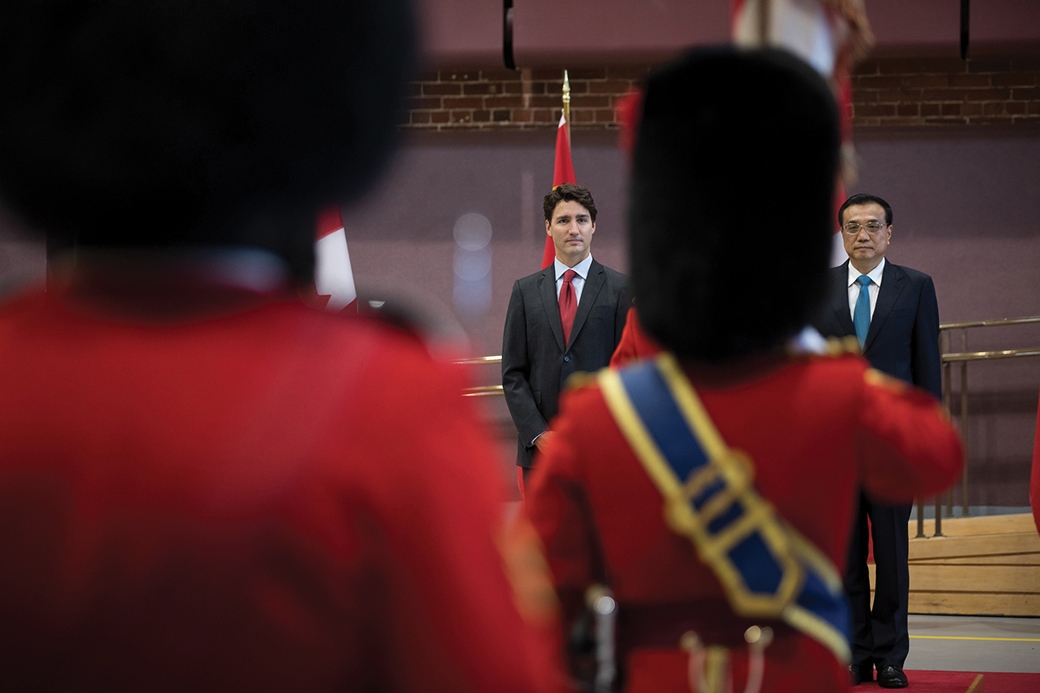
Culture Exchange Promotes Understanding, Brings Countries Closer Despite Distance
In late September 2016, Chinese Premier Li Ke-Qiang paid an official visit to Canada. It was the second visit of a Chinese Premier in 13 years and a return visit after Prime Minister Trudeau’s official visit to China in early September. The consecutive visits of the PMs of the two countries signal further improvement of Canada-China relations. This was the result of accumulative efforts of both sides in many years, as well as the fruition of continuous endeavors in cultural exchanges in recent years.
Canada and China are separated by the vast Pacific Ocean. Nevertheless, the two peoples share mutual friendship and bonds that go back many years. As early as the late 19th century, tens of thousands of Chinese labourers came to Canada to build the Pacific Railways and made valuable contributions to the economic and social development of Canada and its national unity. In the 1930s, Doctor Norman Bethune went to China and sacrificed his life for the Resistance Movement against Japanese Aggression. In 1970s, the visionary leaders of the two countries showed tremendous courage by overcoming barriers to establish diplomatic relations: Canada was among the first western nations to establish diplomatic ties with China. These are part of precious memories of our collective history and should be cherished and honoured for generations to come.
In his article published in The Globe and Mail in September this year, Premier Li Ke-Qiang stated that: “Mutual Trust is the cornerstone of friendly relations and co-operation between Canada and China. Economic co-operation and trade are the driving force of China-Canada relations. People-to-people exchanges are a powerful catalyst for China-Canada friendly co-operation.” In recent years, people-to-people exchanges between Canada and China have increased and the friendly relations between our two peoples have enhanced. This contributed greatly to the overall development of the bilateral relations and is reflected in the following areas:
- Agreements of cultural co-operation between the two governments provided the legal foundation and policy framework for the cultural exchanges. They served as guidance to the exchanges and activities in the cultural domain of two countries. Canada and China signed numerous cultural co-operation agreements and documents, including the latest series during the PMs’ recent visit: Program of Co-operation for the Years 2017-2019 under the Cultural Agreement between the Government of China and the Government of Canada, Film Co-production Treaty between the Government of China and the Government of Canada. The two governments reached consensus on co-operation in Winter Olympics, as well as in other areas, such as libraries. The two governments also announced that Canada will be the Guest of Honour of China Education Expo 2017, and the year 2018 will be China-Canada Tourism Year.
- Multi-annual Large Scale Cultural Exchanges. In 2013-2014, Canada and China successfully co-ordinated a series of cultural exchange activities. In November 2014, the then Canadian Prime Minister Harper visited China and announced with the Chinese Premier that the year 2015-2016 would be designated as “China-Canada Year of People-to-People and Cultural Exchanges”. It was another highlight in the history of China-Canada cultural relationship. In the last four years, the cultural and diplomatic departments of the two countries have had frequent and close contact to fully realize the potential of cultural co-operation. Much has been accomplished in this domain.
- Major co-operative projects. In 2013, the Montreal-Vancouver Tour of the Chinese Central Ballet was the opening act of a series of major cultural exchange activities. It was followed by other impressive projects: in 2014-2016, Toronto Symphony Orchestra held “Annual Chinese New Year Concert”; in 2014, Place des Arts Montreal organized “Spectaculairement Chine”; Toronto Harbourfront Centre held “China Now Festival”; China Shanghai International Arts Festival held “Canadian Culture Week”; in March 2014-Janurary 2015, “The Forbidden City: Inside the Court of China’s Emperors” was exhibited at the Royal Ontario Museum and Vancouver Gallery; in 2015, the fourth “China-Canada Culture Dialogue” was held in Toronto; in 2016, Canada and China co-hosted a photo exhibition and reception in celebration of the 45th anniversary of China-Canada diplomatic ties; “Happy Chinese New Year Flash Event” was held in front of Parliament Hill; Montreal en Lumière invited China as Guest of Honour; Shanghai Ballet conducted two tours in Canada; Canada participated in “Meet in Beijing Art Festival” as Guest of Honour. During this period, National Arts Centre of Canada and National Centre for the Performing Art of China exchanged orchestra visits and continued long-term co-operation. The cultural communities of the two countries organized co-production: Wuxi Song and Dance Theatre and the famous Canadian dance choreographer Peter Quanz collaborated in producing ballet “Red-Crowned Crane” and will tour Canada in the near future. These major cooperative projects run through the streamline of China-Canada cultural exchange while the autonomous co-operation between cultural organizations and agencies further deepened the cultural exchanges. These two elements constitute the backbones of bilateral cultural exchanges.
- Co-operation in cultural industry is taking shape. In tourism, since 2013, Canada and China hosted “China-Canada Tourism Summit”, Beijing Tourist Photo Exhibition, Ningxia Tourism Exhibition and Beijing Tourism Promotion etc. In film and television co-operation, from 2013 on, Guangdong TV Station and Canada Today TV Station concluded landing co-operation; Montreal International Film Festival held consecutive China Film Commerce Week; China International TV Corporation and Xinhua TV Channel conducted program landing trials; in 2016, the first China-Canada International Film Festival was successfully held. In e-game, Canadian game companies organized a delegation to attend “Guangzhou E-Game International Expo” in September 2013; Montreal International Game Summit invited China as Guest of Honour in November 2013; China Cultural Industrial Base and Quebec Digital Union signed a Memorandum of Understanding to establish long-term co-operation in resources complementation and information sharing. Cultural Industry Co-operation is a new area of bilateral cultural co-operation, adding more vitality and persistence to the bilateral cultural relations.
- Down-to-earth, high in popularity, gentle giants charmed the world: Since 2013, Chengdu Research Base of Giant Panda Breeding loaned two giant panda bears to Canada and they became instant sensation. In the third quarter of 2015, Ershun gave birth to twins. Toronto held a national naming contest. In March 2016, Prime Minister Trudeau attended the naming ceremony of panda cubs, the twins were named Jiapanpan (Canadian Hope) and Jiayueyue (Canadian Joy). These two panda cubs are now the stars of Toronto Zoo. They are very popular among Canadians, especially children, and became important catalyst for the promotion of mutual understanding at the grass-roots level.
- Canadian Government and Parliament demonstrated a positive attitude in developing bilateral cultural relations. In recent years, the Canadian government followed through on some of its international obligations on cultural property. Under the framework of UNESCO International Convention on the Prohibition of Illicit Trafficking of Cultural Property, Canada confiscated and returned several Chinese, artifacts including pre-historic fossils and components of ancient buildings, gaining high praise and appreciation from the Chinese government. In June 2016, the Parliament of Canada adopted the motion to proclaim, on an annual basis, the first day of the Chinese Lunar Year as the beginning of the 15-day “Spring Festival”, encouraging people Asian descent to organize celebrations such as “Happy Chinese New Year” in order to enrich multiculturalism of Canada.
- High-level visits to the two countries further deepen the mutual understanding and friendship. Chinese media and websites closely followed the recent Chinese visit of Mr. Trudeau and his family. Images of PM and Mrs. Trudeau and their daughter walking on the Great Wall, PM Trudeau and Chinese basketball star Yao Ming tutoring Shanghai high-school students, PM Trudeau jogging in the park and playing Taiji all generated intense interest from the general public. During Premier Li Ke-Qiang’s visit to Canada, Premier Li took a special trip to Montreal with PM Trudeau and visited the Bell Centre and Premier Li visited the historical exhibition of hockey, watched training session and kicked off the hockey game. These wonderful images played an irreplaceable role in shortening the distance between the two peoples and had a significant impact on the continuous development of China-Canada relations.
Looking forward to the future, the potential of China-Canada cultural exchanges is even greater. The prospects are bright:
- Co-operation in film co-production: China-Canada Agreement on Film Co-production was officially signed and the foundation was laid for co-operation of film co-production. In 2015, the box office revenue exceeded 44 billion RMB (approximately 8 billion Canadian dollars) in China, with more than 31000 films. It is a huge emerging market with tremendous growth potential and will be a highlight of bilateral cultural exchanges.
- Co-operation in Winter Olympics: China is dedicated in developing winter sports and it will be the host of 2022 Winter Olympics. Canada naturally excels in winter sports and Canada’s experience in hosting Winter Olympics is vast. China and Canada reached consensus in co-operation in Winter Olympics and this co-operation is just another example of collaboration.
- Co-operation in tourism: During the visits of Canadian Prime Minister and Chinese Premier in September, China and Canada signed Memorandum of Understanding between the National Tourism Administration of China and the Department of Innovation, Science and Economic Development of Canada in the Field of Tourism, the two sides announced the target of doubling two-way visits by 2025 based on 2015 statistics, and agreed that China will authorise Canada to open 7 additional Canadian visa application centres in China. On top of this, the two governments designated 2018 as China-Canada Tourism Year. These important measures will certainly enhance further interaction and development of China-Canada tourism.
- Canada-China “Happy Chinese New Year” celebrations: the Parliament of Canada adopted the motion on “Spring Festival” in 2016. It encourages Canadians of Chinese descent, Oversea Chinese and communities of Asian heritage to organize more cultural celebration activities during Chinese New Year period. This will contribute to the multiculturalism and culture diversity of Canada.
We firmly believe that, with full support of high-level leadership and active participation and general public engagement, China-Canada cultural exchanges will yield fruitful results and lay a solid foundation in public opinion for China-Canada Strategic Partnership.










